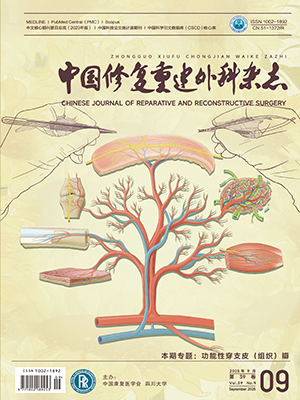| 1. |
Tuček M, Chochola A, Klika D, et al. Epidemiology of scapular fractures. Acta Orthop Belg, 2017, 83(1): 8-15.
|
| 2. |
Neral M, Knapik DM, Wetzel RJ, et al. Scapular body fracture in the athlete: A systematic review. HSS J, 2018, 14(3): 328-332.
|
| 3. |
Tadros AM, Lunsjo K, Czechowski J, et al. Causes of delayed diagnosis of scapular fractures. Injury, 2008, 39(3): 314-318.
|
| 4. |
Surace PA, Boyd AJ, Vallier HA. Case series evaluating the operative and nonoperative treatment of scapular fractures. Am J Orthop (Belle Mead NJ), 2018, 47(8): 1-11.
|
| 5. |
Cole PA Jr, Gilbertson JA, Cole PA Sr. Functional outcomes of operative management of scapula fractures in a geriatric cohort. J Orthop Trauma, 2017, 31(1): e1-e8.
|
| 6. |
Bartonicek J, Klika D, Tucek M. Classification of scapular body fractures. Rozhl Chir, 2018, 97(2): 67-76.
|
| 7. |
Cole PA, Dugarte AJ. Posterior scapula approaches: extensile and modified Judet. J Orthop Trauma, 2018, 32(Suppl 1): S10-S11.
|
| 8. |
Manohara R, Kumar VP. A reverse Judet approach to the scapula. Arch Orthop Trauma Surg, 2018, 138(5): 669-673.
|
| 9. |
Noguchi T, Mautner JF, Duncan SFM. Dorsal plate fixation of scapular fracture. J Hand Surg (Am), 2017, 42(10): 843.e1-843.e5.
|
| 10. |
Ao R, Yu B, Zhu Y, et al. Single lateral versus medial and lateral plates for treating displaced scapular body fractures: a retrospective comparative study. J Shoulder Elbow Surg, 2018, 27(2): 231-236.
|
| 11. |
Hardegger FH, Simpson LA, Weber BG. The operative treatment of scapular fracture. J Bone Joint Surg (Br), 1984, 66(5): 725-731.
|
| 12. |
Schroder LK, Gauger EM, Gilbertson JA, et al. Functional outcomes after operative management of extra-articular glenoid neck and scapular body fractures. J Bone Joint Surg (Am), 2016, 98(19): 1623-1630.
|
| 13. |
Fandridis E, Anastasopoulos PP, Alexiadis G, et al. Posterior subdeltoid and external rotators preserving approach for reduction and fixation of displaced extra-articular fractures of the scapula. Eur J Orthop Surg Traumatol, 2018, 28(4): 585-591.
|
| 14. |
Labronici PJ, Tavares AK, Canhoto EC, et al. Does the position of the scapula in relation to the glenopolar angle change the preferred treatment of extra-articular fractures? Injury, 2017, 48(Suppl 4): S21-S26.
|
| 15. |
Dugarte AJ, Tkany L, Schroder LK, et al. Comparison of 2 versus 3 dimensional fracture mapping strategies for 3 dimensional computerized tomography reconstructions of scapula neck and body fractures. J Orthop Res, 2018, 36(1): 265-271.
|
| 16. |
Suter T, Henninger HB, Zhang Y, et al. Comparison of measurements of the glenopolar angle in 3D CT reconstructions of the scapula and 2D plain radiographic views. Bone Joint J, 2016, 98-B(11): 1510-1516.
|
| 17. |
Kejriwal R, Ahuja T, Hong T. Is radiograph glenopolar angle accurate for extraarticular scapular neck fractures? Injury, 2016, 47(12): 2772-2776.
|
| 18. |
Chang AC, Phadnis J, Eardley-Harris N, et al. Inferior angle of scapula fractures: a review of literature and evidence-based treatment guidelines. J Shoulder Elbow Surg, 2016, 25(7): 1170-1174.
|
| 19. |
Zahid M, Rashid EH, Inam H, et al. Outcomes of open reduction and internal fixation in displaced intra-articular scapular fractures: a case series. Acta Orthop Belg, 2017, 83(1): 16-21.
|




